Total Quality Management and Performance
VerifiedAdded on 2021/04/21
|16
|2881
|32
AI Summary
This assignment delves into the world of total quality management (TQM), a philosophy that aims to enhance organizational performance by focusing on continuous improvement, employee involvement, and customer satisfaction. The task involves analyzing the relationship between TQM and business success, identifying key factors that influence its effectiveness, and discussing the impact of TQM on organizational performance. A thorough understanding of TQM concepts, principles, and practices is required to complete this assignment.
Contribute Materials
Your contribution can guide someone’s learning journey. Share your
documents today.
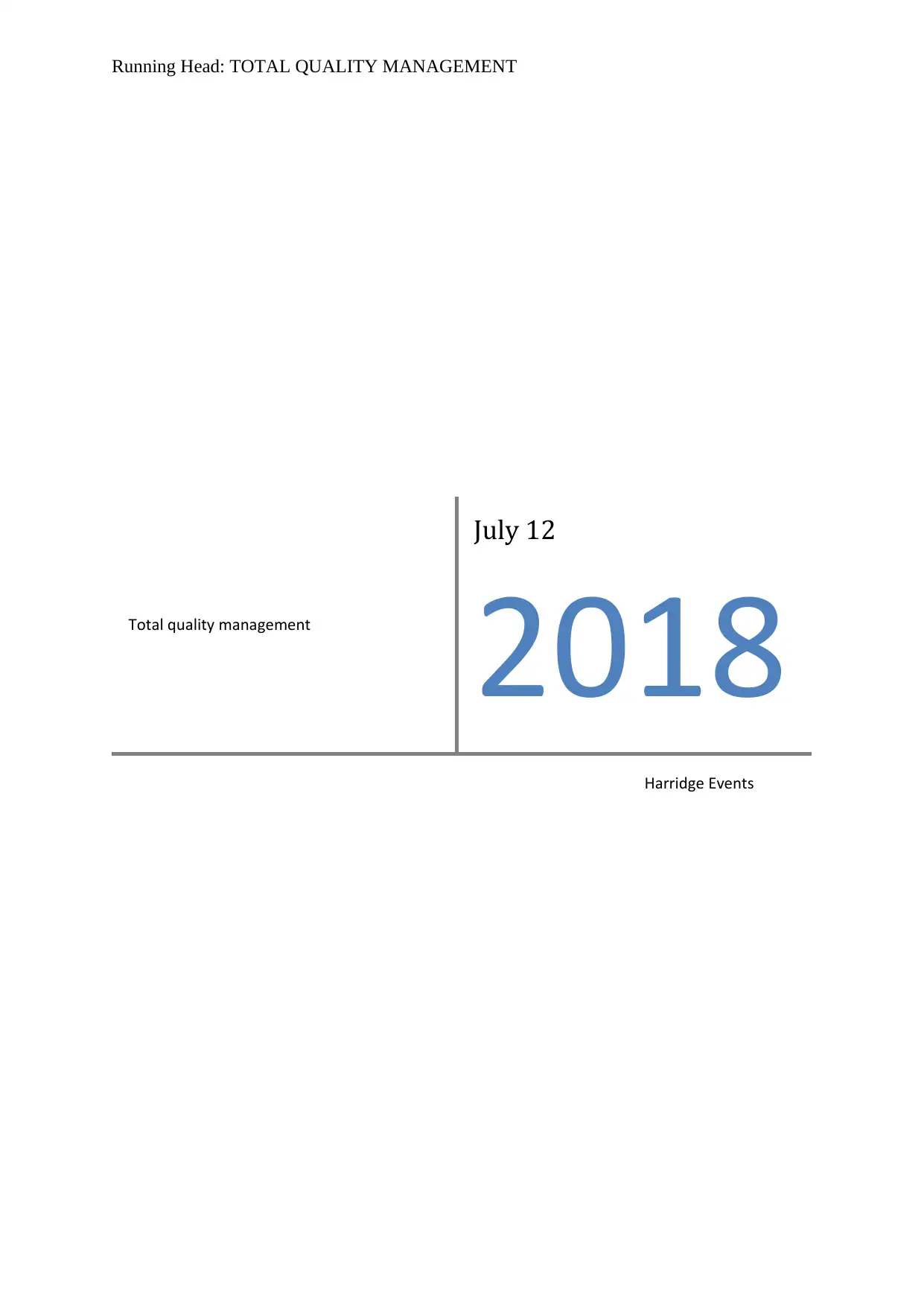
Running Head: TOTAL QUALITY MANAGEMENT
Total quality management
July 12
2018
Harridge Events
Total quality management
July 12
2018
Harridge Events
Secure Best Marks with AI Grader
Need help grading? Try our AI Grader for instant feedback on your assignments.
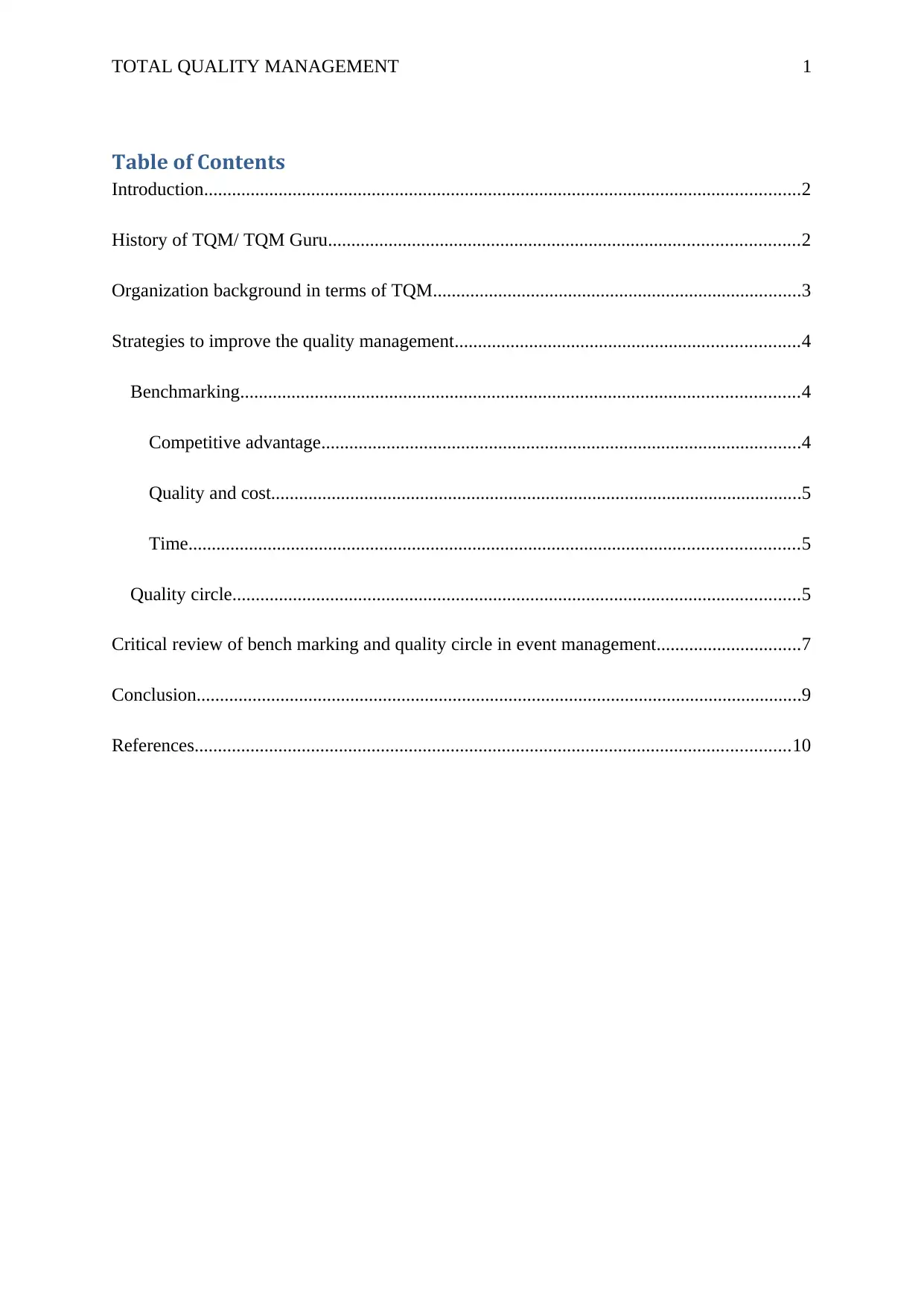
TOTAL QUALITY MANAGEMENT 1
Table of Contents
Introduction................................................................................................................................2
History of TQM/ TQM Guru.....................................................................................................2
Organization background in terms of TQM...............................................................................3
Strategies to improve the quality management..........................................................................4
Benchmarking........................................................................................................................4
Competitive advantage.......................................................................................................4
Quality and cost..................................................................................................................5
Time...................................................................................................................................5
Quality circle..........................................................................................................................5
Critical review of bench marking and quality circle in event management...............................7
Conclusion..................................................................................................................................9
References................................................................................................................................10
Table of Contents
Introduction................................................................................................................................2
History of TQM/ TQM Guru.....................................................................................................2
Organization background in terms of TQM...............................................................................3
Strategies to improve the quality management..........................................................................4
Benchmarking........................................................................................................................4
Competitive advantage.......................................................................................................4
Quality and cost..................................................................................................................5
Time...................................................................................................................................5
Quality circle..........................................................................................................................5
Critical review of bench marking and quality circle in event management...............................7
Conclusion..................................................................................................................................9
References................................................................................................................................10
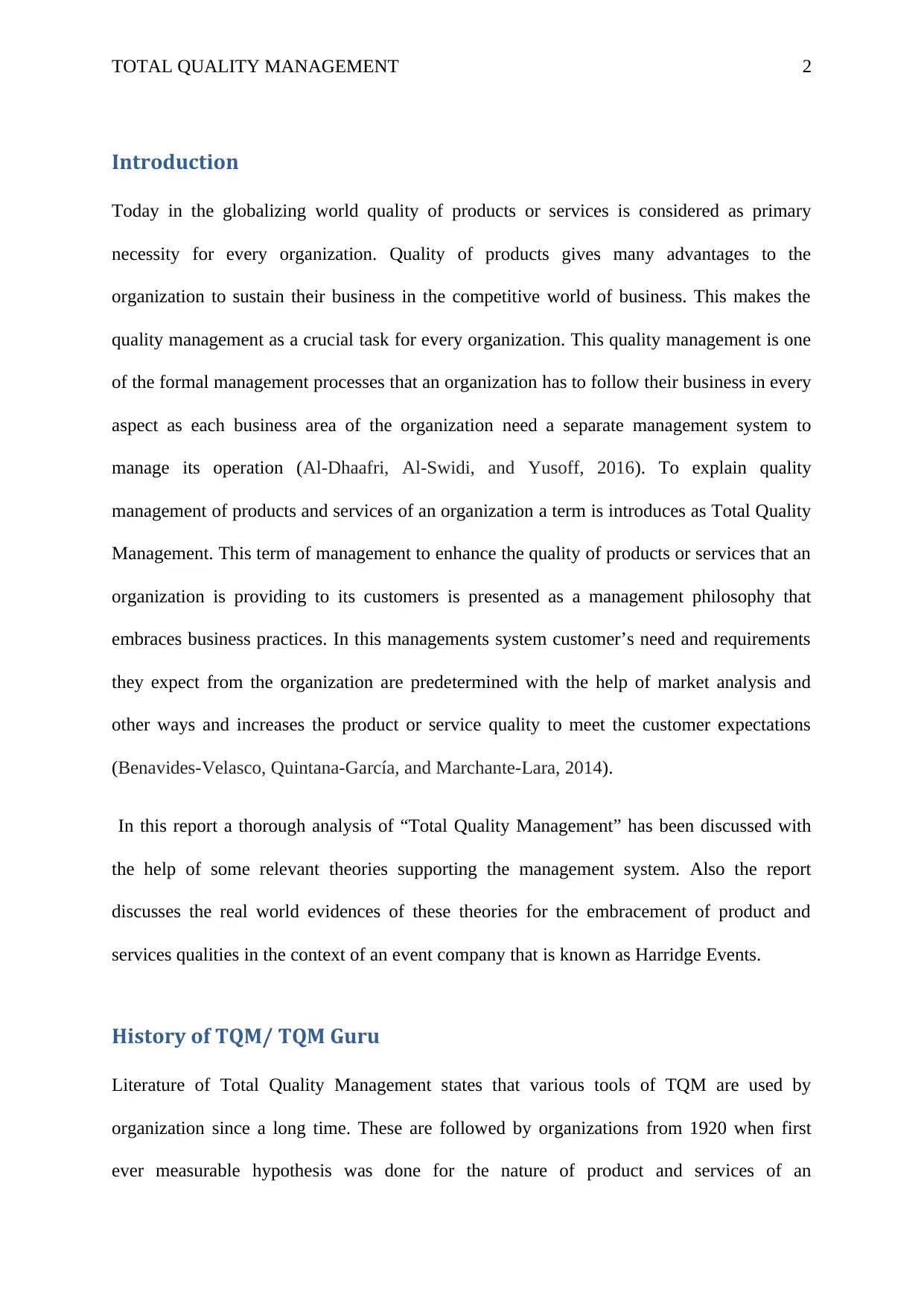
TOTAL QUALITY MANAGEMENT 2
Introduction
Today in the globalizing world quality of products or services is considered as primary
necessity for every organization. Quality of products gives many advantages to the
organization to sustain their business in the competitive world of business. This makes the
quality management as a crucial task for every organization. This quality management is one
of the formal management processes that an organization has to follow their business in every
aspect as each business area of the organization need a separate management system to
manage its operation (Al-Dhaafri, Al-Swidi, and Yusoff, 2016). To explain quality
management of products and services of an organization a term is introduces as Total Quality
Management. This term of management to enhance the quality of products or services that an
organization is providing to its customers is presented as a management philosophy that
embraces business practices. In this managements system customer’s need and requirements
they expect from the organization are predetermined with the help of market analysis and
other ways and increases the product or service quality to meet the customer expectations
(Benavides-Velasco, Quintana-García, and Marchante-Lara, 2014).
In this report a thorough analysis of “Total Quality Management” has been discussed with
the help of some relevant theories supporting the management system. Also the report
discusses the real world evidences of these theories for the embracement of product and
services qualities in the context of an event company that is known as Harridge Events.
History of TQM/ TQM Guru
Literature of Total Quality Management states that various tools of TQM are used by
organization since a long time. These are followed by organizations from 1920 when first
ever measurable hypothesis was done for the nature of product and services of an
Introduction
Today in the globalizing world quality of products or services is considered as primary
necessity for every organization. Quality of products gives many advantages to the
organization to sustain their business in the competitive world of business. This makes the
quality management as a crucial task for every organization. This quality management is one
of the formal management processes that an organization has to follow their business in every
aspect as each business area of the organization need a separate management system to
manage its operation (Al-Dhaafri, Al-Swidi, and Yusoff, 2016). To explain quality
management of products and services of an organization a term is introduces as Total Quality
Management. This term of management to enhance the quality of products or services that an
organization is providing to its customers is presented as a management philosophy that
embraces business practices. In this managements system customer’s need and requirements
they expect from the organization are predetermined with the help of market analysis and
other ways and increases the product or service quality to meet the customer expectations
(Benavides-Velasco, Quintana-García, and Marchante-Lara, 2014).
In this report a thorough analysis of “Total Quality Management” has been discussed with
the help of some relevant theories supporting the management system. Also the report
discusses the real world evidences of these theories for the embracement of product and
services qualities in the context of an event company that is known as Harridge Events.
History of TQM/ TQM Guru
Literature of Total Quality Management states that various tools of TQM are used by
organization since a long time. These are followed by organizations from 1920 when first
ever measurable hypothesis was done for the nature of product and services of an
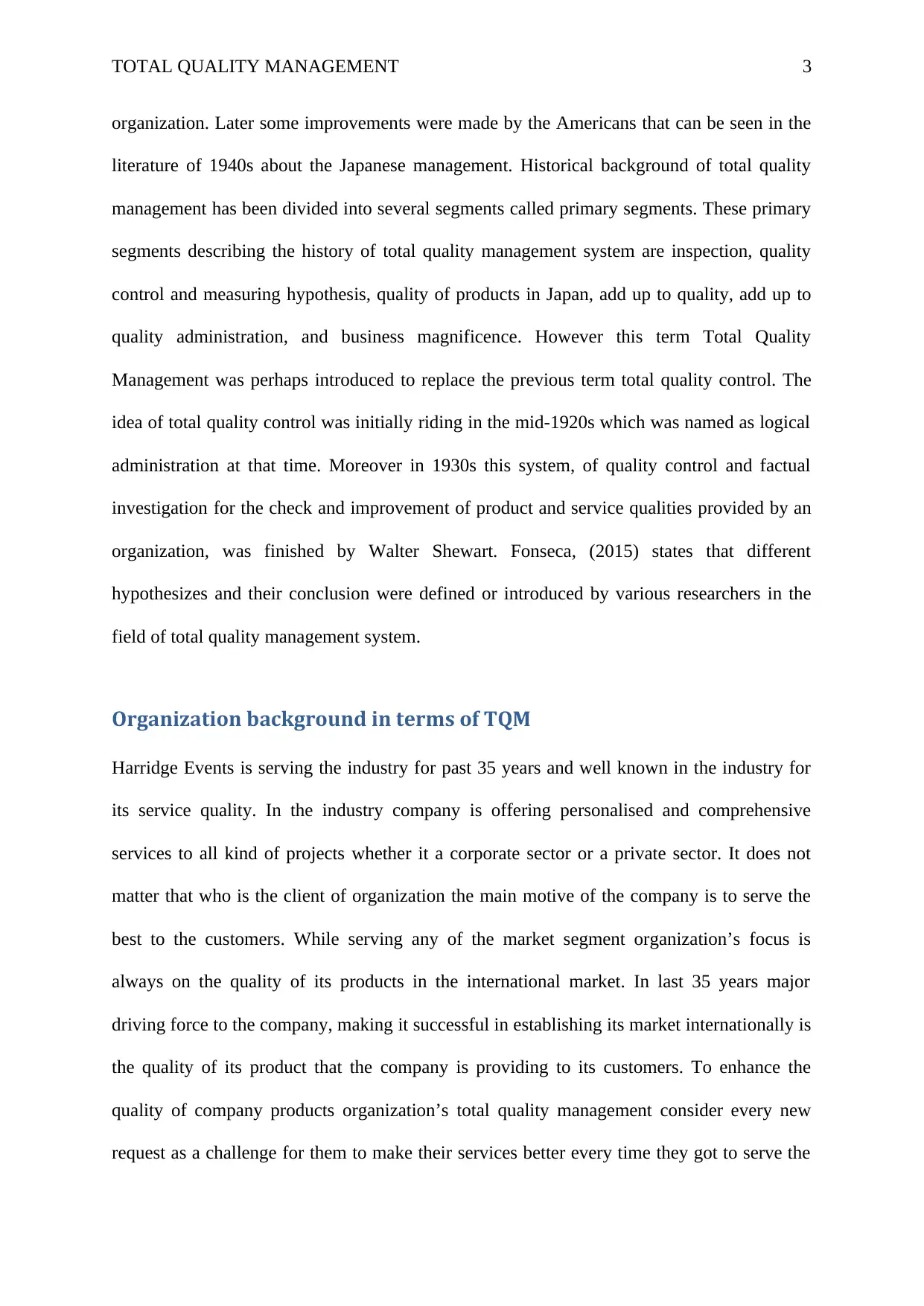
TOTAL QUALITY MANAGEMENT 3
organization. Later some improvements were made by the Americans that can be seen in the
literature of 1940s about the Japanese management. Historical background of total quality
management has been divided into several segments called primary segments. These primary
segments describing the history of total quality management system are inspection, quality
control and measuring hypothesis, quality of products in Japan, add up to quality, add up to
quality administration, and business magnificence. However this term Total Quality
Management was perhaps introduced to replace the previous term total quality control. The
idea of total quality control was initially riding in the mid-1920s which was named as logical
administration at that time. Moreover in 1930s this system, of quality control and factual
investigation for the check and improvement of product and service qualities provided by an
organization, was finished by Walter Shewart. Fonseca, (2015) states that different
hypothesizes and their conclusion were defined or introduced by various researchers in the
field of total quality management system.
Organization background in terms of TQM
Harridge Events is serving the industry for past 35 years and well known in the industry for
its service quality. In the industry company is offering personalised and comprehensive
services to all kind of projects whether it a corporate sector or a private sector. It does not
matter that who is the client of organization the main motive of the company is to serve the
best to the customers. While serving any of the market segment organization’s focus is
always on the quality of its products in the international market. In last 35 years major
driving force to the company, making it successful in establishing its market internationally is
the quality of its product that the company is providing to its customers. To enhance the
quality of company products organization’s total quality management consider every new
request as a challenge for them to make their services better every time they got to serve the
organization. Later some improvements were made by the Americans that can be seen in the
literature of 1940s about the Japanese management. Historical background of total quality
management has been divided into several segments called primary segments. These primary
segments describing the history of total quality management system are inspection, quality
control and measuring hypothesis, quality of products in Japan, add up to quality, add up to
quality administration, and business magnificence. However this term Total Quality
Management was perhaps introduced to replace the previous term total quality control. The
idea of total quality control was initially riding in the mid-1920s which was named as logical
administration at that time. Moreover in 1930s this system, of quality control and factual
investigation for the check and improvement of product and service qualities provided by an
organization, was finished by Walter Shewart. Fonseca, (2015) states that different
hypothesizes and their conclusion were defined or introduced by various researchers in the
field of total quality management system.
Organization background in terms of TQM
Harridge Events is serving the industry for past 35 years and well known in the industry for
its service quality. In the industry company is offering personalised and comprehensive
services to all kind of projects whether it a corporate sector or a private sector. It does not
matter that who is the client of organization the main motive of the company is to serve the
best to the customers. While serving any of the market segment organization’s focus is
always on the quality of its products in the international market. In last 35 years major
driving force to the company, making it successful in establishing its market internationally is
the quality of its product that the company is providing to its customers. To enhance the
quality of company products organization’s total quality management consider every new
request as a challenge for them to make their services better every time they got to serve the
Secure Best Marks with AI Grader
Need help grading? Try our AI Grader for instant feedback on your assignments.
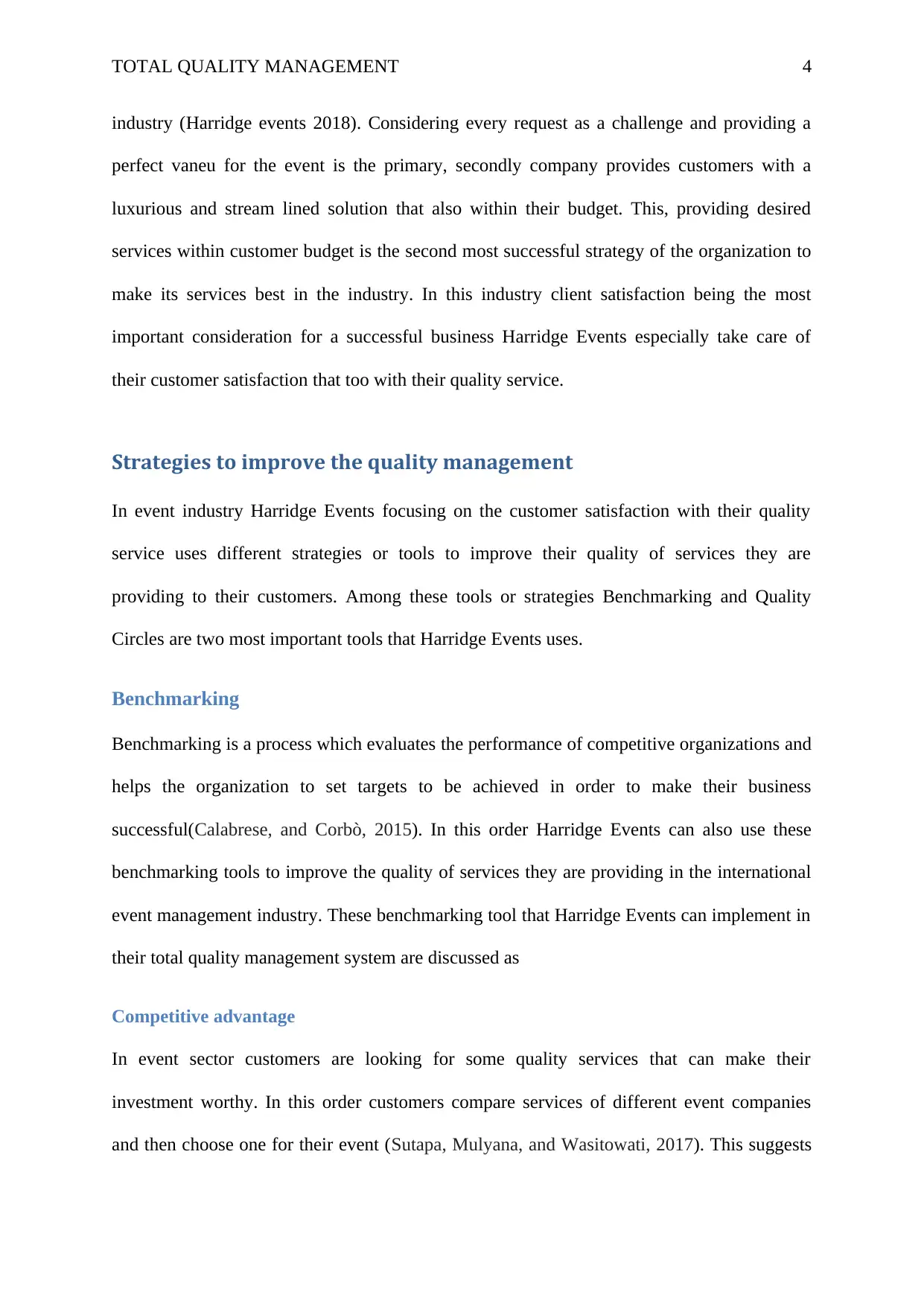
TOTAL QUALITY MANAGEMENT 4
industry (Harridge events 2018). Considering every request as a challenge and providing a
perfect vaneu for the event is the primary, secondly company provides customers with a
luxurious and stream lined solution that also within their budget. This, providing desired
services within customer budget is the second most successful strategy of the organization to
make its services best in the industry. In this industry client satisfaction being the most
important consideration for a successful business Harridge Events especially take care of
their customer satisfaction that too with their quality service.
Strategies to improve the quality management
In event industry Harridge Events focusing on the customer satisfaction with their quality
service uses different strategies or tools to improve their quality of services they are
providing to their customers. Among these tools or strategies Benchmarking and Quality
Circles are two most important tools that Harridge Events uses.
Benchmarking
Benchmarking is a process which evaluates the performance of competitive organizations and
helps the organization to set targets to be achieved in order to make their business
successful(Calabrese, and Corbò, 2015). In this order Harridge Events can also use these
benchmarking tools to improve the quality of services they are providing in the international
event management industry. These benchmarking tool that Harridge Events can implement in
their total quality management system are discussed as
Competitive advantage
In event sector customers are looking for some quality services that can make their
investment worthy. In this order customers compare services of different event companies
and then choose one for their event (Sutapa, Mulyana, and Wasitowati, 2017). This suggests
industry (Harridge events 2018). Considering every request as a challenge and providing a
perfect vaneu for the event is the primary, secondly company provides customers with a
luxurious and stream lined solution that also within their budget. This, providing desired
services within customer budget is the second most successful strategy of the organization to
make its services best in the industry. In this industry client satisfaction being the most
important consideration for a successful business Harridge Events especially take care of
their customer satisfaction that too with their quality service.
Strategies to improve the quality management
In event industry Harridge Events focusing on the customer satisfaction with their quality
service uses different strategies or tools to improve their quality of services they are
providing to their customers. Among these tools or strategies Benchmarking and Quality
Circles are two most important tools that Harridge Events uses.
Benchmarking
Benchmarking is a process which evaluates the performance of competitive organizations and
helps the organization to set targets to be achieved in order to make their business
successful(Calabrese, and Corbò, 2015). In this order Harridge Events can also use these
benchmarking tools to improve the quality of services they are providing in the international
event management industry. These benchmarking tool that Harridge Events can implement in
their total quality management system are discussed as
Competitive advantage
In event sector customers are looking for some quality services that can make their
investment worthy. In this order customers compare services of different event companies
and then choose one for their event (Sutapa, Mulyana, and Wasitowati, 2017). This suggests
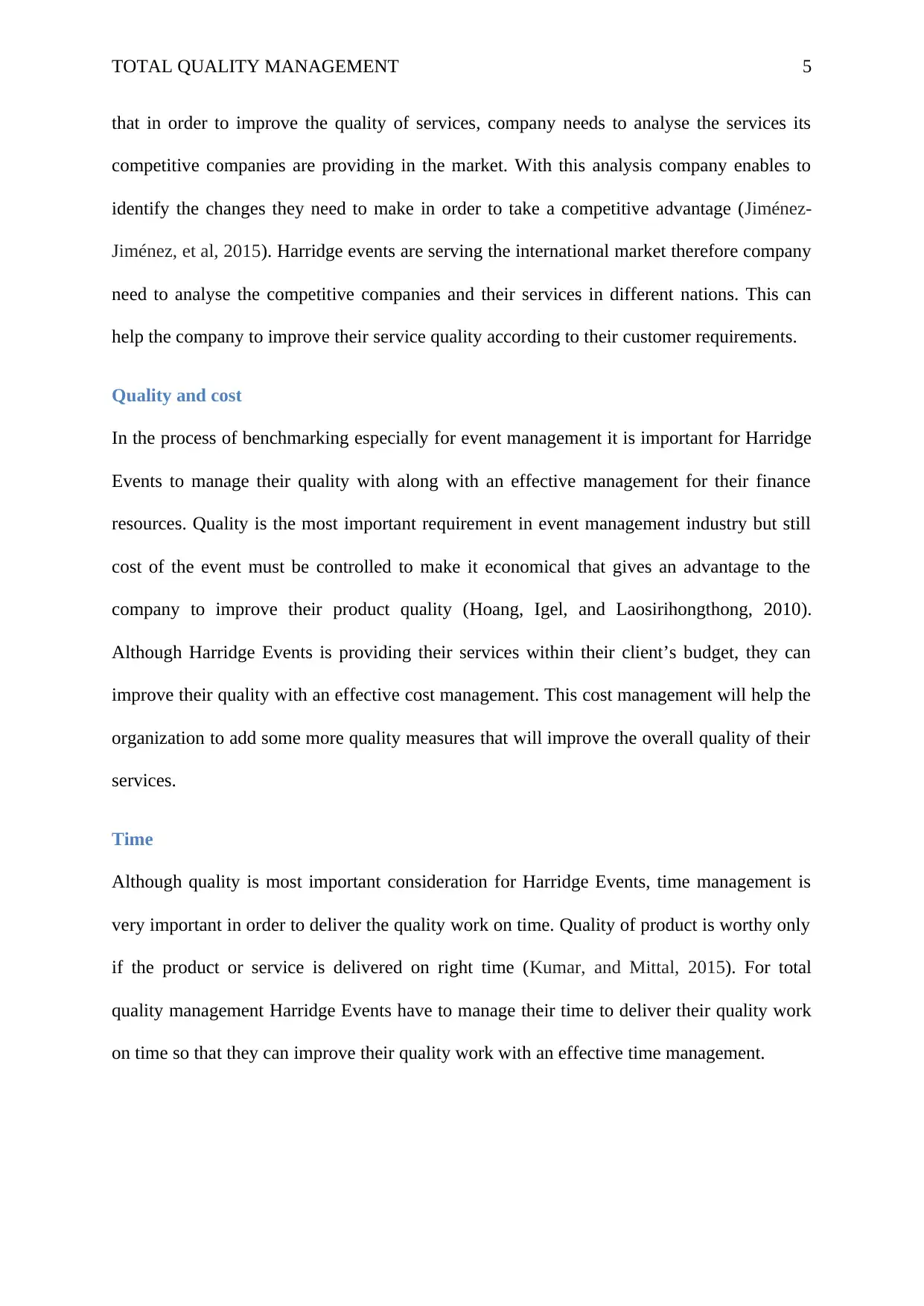
TOTAL QUALITY MANAGEMENT 5
that in order to improve the quality of services, company needs to analyse the services its
competitive companies are providing in the market. With this analysis company enables to
identify the changes they need to make in order to take a competitive advantage (Jiménez-
Jiménez, et al, 2015). Harridge events are serving the international market therefore company
need to analyse the competitive companies and their services in different nations. This can
help the company to improve their service quality according to their customer requirements.
Quality and cost
In the process of benchmarking especially for event management it is important for Harridge
Events to manage their quality with along with an effective management for their finance
resources. Quality is the most important requirement in event management industry but still
cost of the event must be controlled to make it economical that gives an advantage to the
company to improve their product quality (Hoang, Igel, and Laosirihongthong, 2010).
Although Harridge Events is providing their services within their client’s budget, they can
improve their quality with an effective cost management. This cost management will help the
organization to add some more quality measures that will improve the overall quality of their
services.
Time
Although quality is most important consideration for Harridge Events, time management is
very important in order to deliver the quality work on time. Quality of product is worthy only
if the product or service is delivered on right time (Kumar, and Mittal, 2015). For total
quality management Harridge Events have to manage their time to deliver their quality work
on time so that they can improve their quality work with an effective time management.
that in order to improve the quality of services, company needs to analyse the services its
competitive companies are providing in the market. With this analysis company enables to
identify the changes they need to make in order to take a competitive advantage (Jiménez-
Jiménez, et al, 2015). Harridge events are serving the international market therefore company
need to analyse the competitive companies and their services in different nations. This can
help the company to improve their service quality according to their customer requirements.
Quality and cost
In the process of benchmarking especially for event management it is important for Harridge
Events to manage their quality with along with an effective management for their finance
resources. Quality is the most important requirement in event management industry but still
cost of the event must be controlled to make it economical that gives an advantage to the
company to improve their product quality (Hoang, Igel, and Laosirihongthong, 2010).
Although Harridge Events is providing their services within their client’s budget, they can
improve their quality with an effective cost management. This cost management will help the
organization to add some more quality measures that will improve the overall quality of their
services.
Time
Although quality is most important consideration for Harridge Events, time management is
very important in order to deliver the quality work on time. Quality of product is worthy only
if the product or service is delivered on right time (Kumar, and Mittal, 2015). For total
quality management Harridge Events have to manage their time to deliver their quality work
on time so that they can improve their quality work with an effective time management.
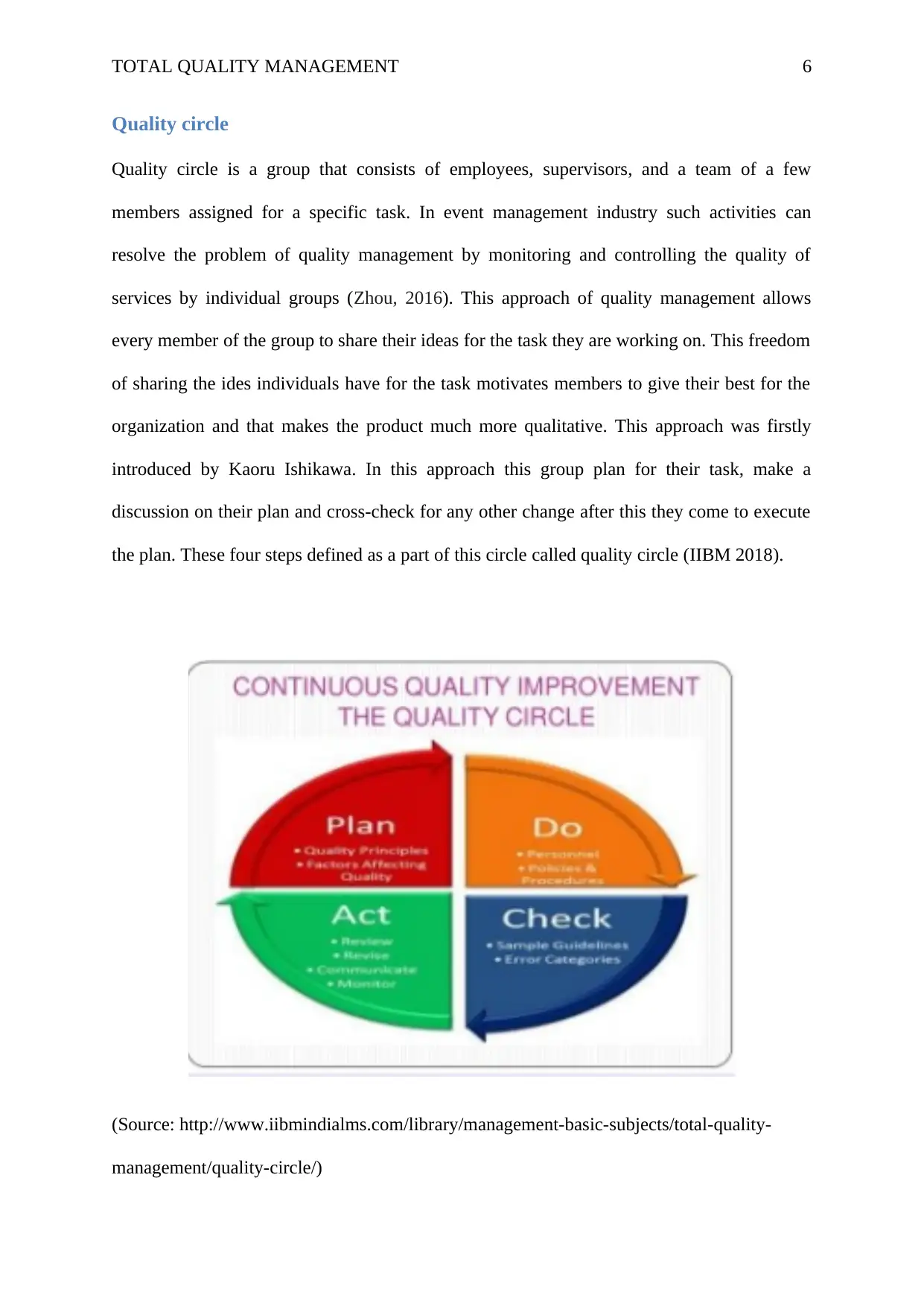
TOTAL QUALITY MANAGEMENT 6
Quality circle
Quality circle is a group that consists of employees, supervisors, and a team of a few
members assigned for a specific task. In event management industry such activities can
resolve the problem of quality management by monitoring and controlling the quality of
services by individual groups (Zhou, 2016). This approach of quality management allows
every member of the group to share their ideas for the task they are working on. This freedom
of sharing the ides individuals have for the task motivates members to give their best for the
organization and that makes the product much more qualitative. This approach was firstly
introduced by Kaoru Ishikawa. In this approach this group plan for their task, make a
discussion on their plan and cross-check for any other change after this they come to execute
the plan. These four steps defined as a part of this circle called quality circle (IIBM 2018).
(Source: http://www.iibmindialms.com/library/management-basic-subjects/total-quality-
management/quality-circle/)
Quality circle
Quality circle is a group that consists of employees, supervisors, and a team of a few
members assigned for a specific task. In event management industry such activities can
resolve the problem of quality management by monitoring and controlling the quality of
services by individual groups (Zhou, 2016). This approach of quality management allows
every member of the group to share their ideas for the task they are working on. This freedom
of sharing the ides individuals have for the task motivates members to give their best for the
organization and that makes the product much more qualitative. This approach was firstly
introduced by Kaoru Ishikawa. In this approach this group plan for their task, make a
discussion on their plan and cross-check for any other change after this they come to execute
the plan. These four steps defined as a part of this circle called quality circle (IIBM 2018).
(Source: http://www.iibmindialms.com/library/management-basic-subjects/total-quality-
management/quality-circle/)
Paraphrase This Document
Need a fresh take? Get an instant paraphrase of this document with our AI Paraphraser
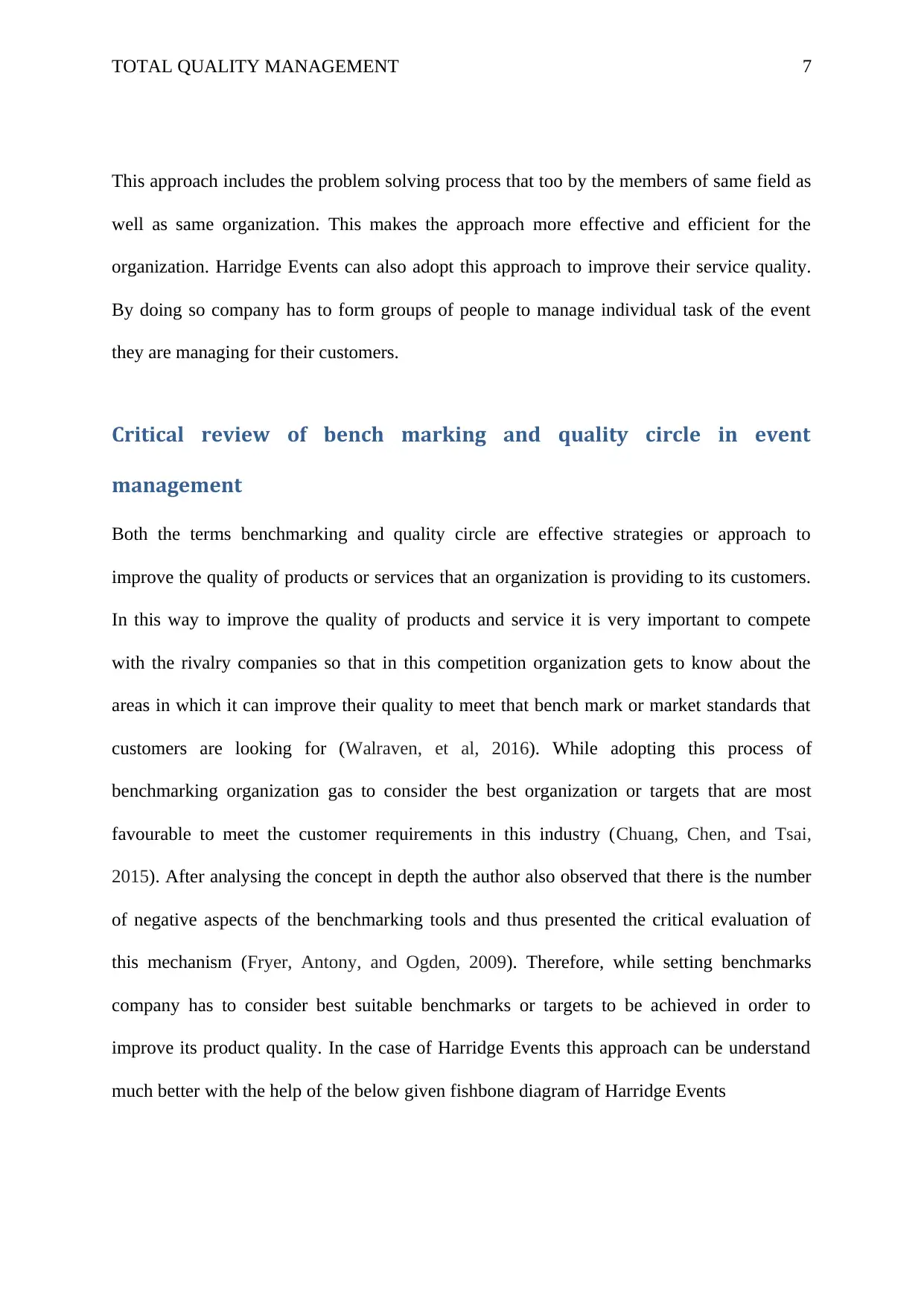
TOTAL QUALITY MANAGEMENT 7
This approach includes the problem solving process that too by the members of same field as
well as same organization. This makes the approach more effective and efficient for the
organization. Harridge Events can also adopt this approach to improve their service quality.
By doing so company has to form groups of people to manage individual task of the event
they are managing for their customers.
Critical review of bench marking and quality circle in event
management
Both the terms benchmarking and quality circle are effective strategies or approach to
improve the quality of products or services that an organization is providing to its customers.
In this way to improve the quality of products and service it is very important to compete
with the rivalry companies so that in this competition organization gets to know about the
areas in which it can improve their quality to meet that bench mark or market standards that
customers are looking for (Walraven, et al, 2016). While adopting this process of
benchmarking organization gas to consider the best organization or targets that are most
favourable to meet the customer requirements in this industry (Chuang, Chen, and Tsai,
2015). After analysing the concept in depth the author also observed that there is the number
of negative aspects of the benchmarking tools and thus presented the critical evaluation of
this mechanism (Fryer, Antony, and Ogden, 2009). Therefore, while setting benchmarks
company has to consider best suitable benchmarks or targets to be achieved in order to
improve its product quality. In the case of Harridge Events this approach can be understand
much better with the help of the below given fishbone diagram of Harridge Events
This approach includes the problem solving process that too by the members of same field as
well as same organization. This makes the approach more effective and efficient for the
organization. Harridge Events can also adopt this approach to improve their service quality.
By doing so company has to form groups of people to manage individual task of the event
they are managing for their customers.
Critical review of bench marking and quality circle in event
management
Both the terms benchmarking and quality circle are effective strategies or approach to
improve the quality of products or services that an organization is providing to its customers.
In this way to improve the quality of products and service it is very important to compete
with the rivalry companies so that in this competition organization gets to know about the
areas in which it can improve their quality to meet that bench mark or market standards that
customers are looking for (Walraven, et al, 2016). While adopting this process of
benchmarking organization gas to consider the best organization or targets that are most
favourable to meet the customer requirements in this industry (Chuang, Chen, and Tsai,
2015). After analysing the concept in depth the author also observed that there is the number
of negative aspects of the benchmarking tools and thus presented the critical evaluation of
this mechanism (Fryer, Antony, and Ogden, 2009). Therefore, while setting benchmarks
company has to consider best suitable benchmarks or targets to be achieved in order to
improve its product quality. In the case of Harridge Events this approach can be understand
much better with the help of the below given fishbone diagram of Harridge Events
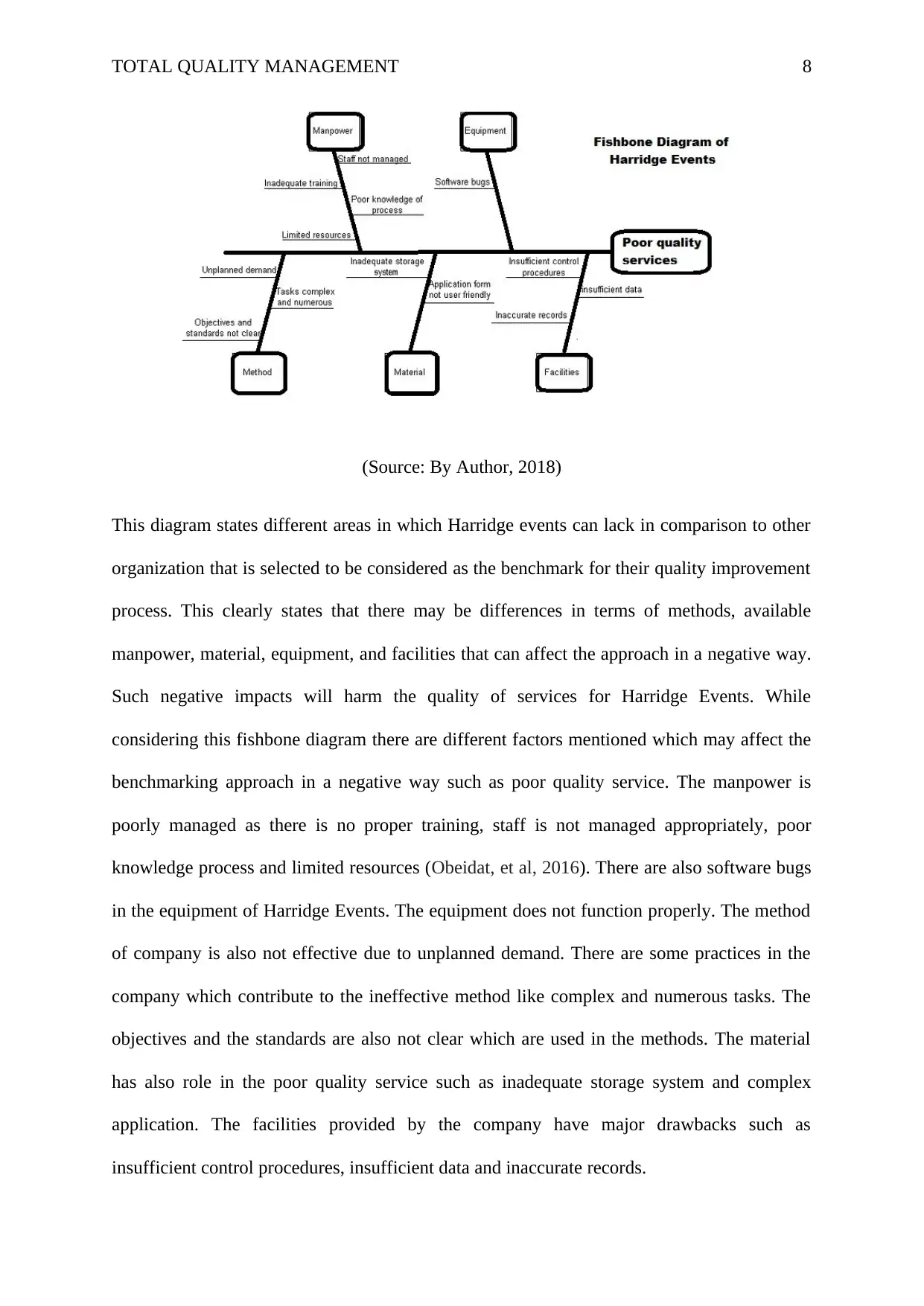
TOTAL QUALITY MANAGEMENT 8
(Source: By Author, 2018)
This diagram states different areas in which Harridge events can lack in comparison to other
organization that is selected to be considered as the benchmark for their quality improvement
process. This clearly states that there may be differences in terms of methods, available
manpower, material, equipment, and facilities that can affect the approach in a negative way.
Such negative impacts will harm the quality of services for Harridge Events. While
considering this fishbone diagram there are different factors mentioned which may affect the
benchmarking approach in a negative way such as poor quality service. The manpower is
poorly managed as there is no proper training, staff is not managed appropriately, poor
knowledge process and limited resources (Obeidat, et al, 2016). There are also software bugs
in the equipment of Harridge Events. The equipment does not function properly. The method
of company is also not effective due to unplanned demand. There are some practices in the
company which contribute to the ineffective method like complex and numerous tasks. The
objectives and the standards are also not clear which are used in the methods. The material
has also role in the poor quality service such as inadequate storage system and complex
application. The facilities provided by the company have major drawbacks such as
insufficient control procedures, insufficient data and inaccurate records.
(Source: By Author, 2018)
This diagram states different areas in which Harridge events can lack in comparison to other
organization that is selected to be considered as the benchmark for their quality improvement
process. This clearly states that there may be differences in terms of methods, available
manpower, material, equipment, and facilities that can affect the approach in a negative way.
Such negative impacts will harm the quality of services for Harridge Events. While
considering this fishbone diagram there are different factors mentioned which may affect the
benchmarking approach in a negative way such as poor quality service. The manpower is
poorly managed as there is no proper training, staff is not managed appropriately, poor
knowledge process and limited resources (Obeidat, et al, 2016). There are also software bugs
in the equipment of Harridge Events. The equipment does not function properly. The method
of company is also not effective due to unplanned demand. There are some practices in the
company which contribute to the ineffective method like complex and numerous tasks. The
objectives and the standards are also not clear which are used in the methods. The material
has also role in the poor quality service such as inadequate storage system and complex
application. The facilities provided by the company have major drawbacks such as
insufficient control procedures, insufficient data and inaccurate records.
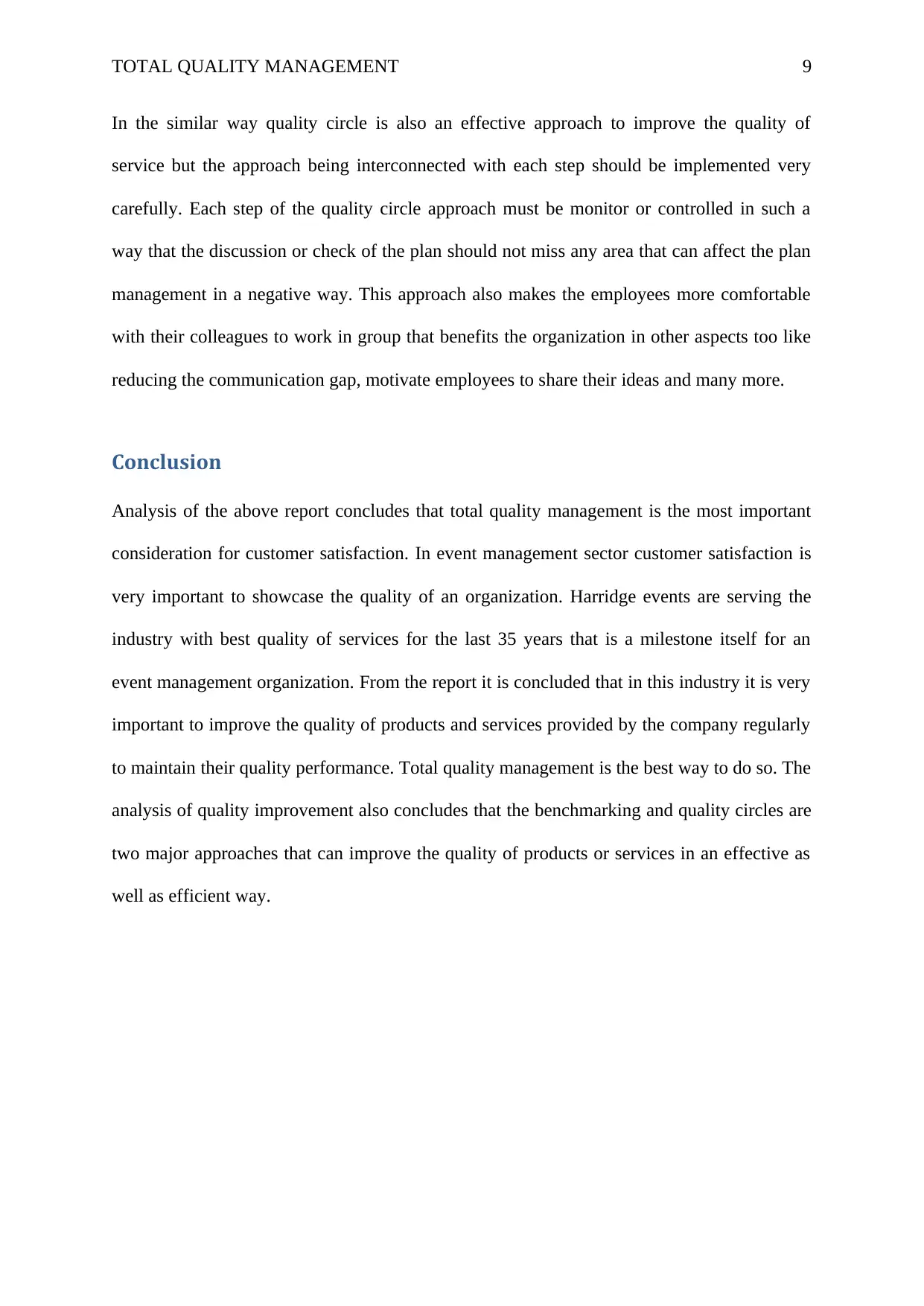
TOTAL QUALITY MANAGEMENT 9
In the similar way quality circle is also an effective approach to improve the quality of
service but the approach being interconnected with each step should be implemented very
carefully. Each step of the quality circle approach must be monitor or controlled in such a
way that the discussion or check of the plan should not miss any area that can affect the plan
management in a negative way. This approach also makes the employees more comfortable
with their colleagues to work in group that benefits the organization in other aspects too like
reducing the communication gap, motivate employees to share their ideas and many more.
Conclusion
Analysis of the above report concludes that total quality management is the most important
consideration for customer satisfaction. In event management sector customer satisfaction is
very important to showcase the quality of an organization. Harridge events are serving the
industry with best quality of services for the last 35 years that is a milestone itself for an
event management organization. From the report it is concluded that in this industry it is very
important to improve the quality of products and services provided by the company regularly
to maintain their quality performance. Total quality management is the best way to do so. The
analysis of quality improvement also concludes that the benchmarking and quality circles are
two major approaches that can improve the quality of products or services in an effective as
well as efficient way.
In the similar way quality circle is also an effective approach to improve the quality of
service but the approach being interconnected with each step should be implemented very
carefully. Each step of the quality circle approach must be monitor or controlled in such a
way that the discussion or check of the plan should not miss any area that can affect the plan
management in a negative way. This approach also makes the employees more comfortable
with their colleagues to work in group that benefits the organization in other aspects too like
reducing the communication gap, motivate employees to share their ideas and many more.
Conclusion
Analysis of the above report concludes that total quality management is the most important
consideration for customer satisfaction. In event management sector customer satisfaction is
very important to showcase the quality of an organization. Harridge events are serving the
industry with best quality of services for the last 35 years that is a milestone itself for an
event management organization. From the report it is concluded that in this industry it is very
important to improve the quality of products and services provided by the company regularly
to maintain their quality performance. Total quality management is the best way to do so. The
analysis of quality improvement also concludes that the benchmarking and quality circles are
two major approaches that can improve the quality of products or services in an effective as
well as efficient way.
Secure Best Marks with AI Grader
Need help grading? Try our AI Grader for instant feedback on your assignments.
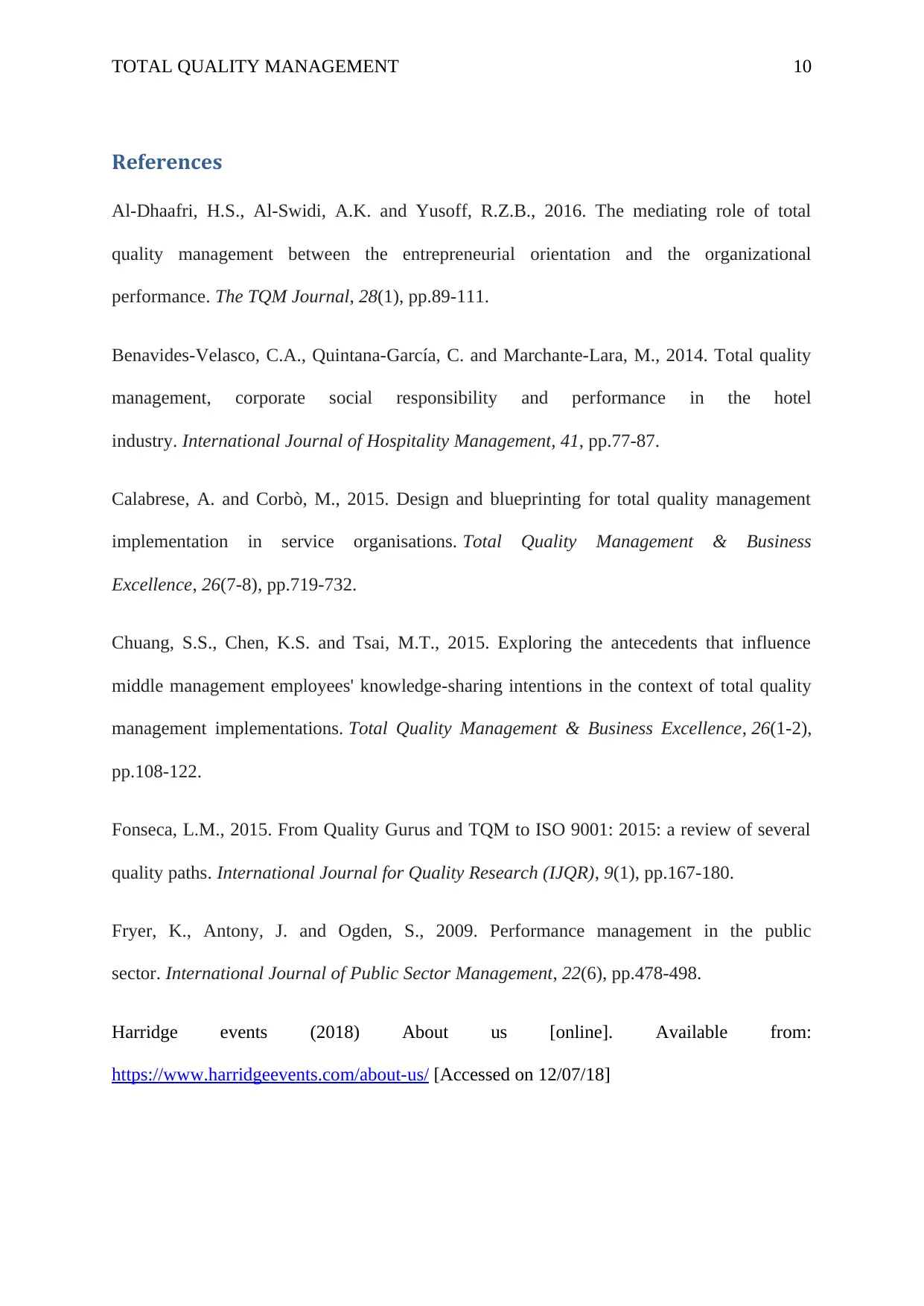
TOTAL QUALITY MANAGEMENT 10
References
Al-Dhaafri, H.S., Al-Swidi, A.K. and Yusoff, R.Z.B., 2016. The mediating role of total
quality management between the entrepreneurial orientation and the organizational
performance. The TQM Journal, 28(1), pp.89-111.
Benavides-Velasco, C.A., Quintana-García, C. and Marchante-Lara, M., 2014. Total quality
management, corporate social responsibility and performance in the hotel
industry. International Journal of Hospitality Management, 41, pp.77-87.
Calabrese, A. and Corbò, M., 2015. Design and blueprinting for total quality management
implementation in service organisations. Total Quality Management & Business
Excellence, 26(7-8), pp.719-732.
Chuang, S.S., Chen, K.S. and Tsai, M.T., 2015. Exploring the antecedents that influence
middle management employees' knowledge-sharing intentions in the context of total quality
management implementations. Total Quality Management & Business Excellence, 26(1-2),
pp.108-122.
Fonseca, L.M., 2015. From Quality Gurus and TQM to ISO 9001: 2015: a review of several
quality paths. International Journal for Quality Research (IJQR), 9(1), pp.167-180.
Fryer, K., Antony, J. and Ogden, S., 2009. Performance management in the public
sector. International Journal of Public Sector Management, 22(6), pp.478-498.
Harridge events (2018) About us [online]. Available from:
https://www.harridgeevents.com/about-us/ [Accessed on 12/07/18]
References
Al-Dhaafri, H.S., Al-Swidi, A.K. and Yusoff, R.Z.B., 2016. The mediating role of total
quality management between the entrepreneurial orientation and the organizational
performance. The TQM Journal, 28(1), pp.89-111.
Benavides-Velasco, C.A., Quintana-García, C. and Marchante-Lara, M., 2014. Total quality
management, corporate social responsibility and performance in the hotel
industry. International Journal of Hospitality Management, 41, pp.77-87.
Calabrese, A. and Corbò, M., 2015. Design and blueprinting for total quality management
implementation in service organisations. Total Quality Management & Business
Excellence, 26(7-8), pp.719-732.
Chuang, S.S., Chen, K.S. and Tsai, M.T., 2015. Exploring the antecedents that influence
middle management employees' knowledge-sharing intentions in the context of total quality
management implementations. Total Quality Management & Business Excellence, 26(1-2),
pp.108-122.
Fonseca, L.M., 2015. From Quality Gurus and TQM to ISO 9001: 2015: a review of several
quality paths. International Journal for Quality Research (IJQR), 9(1), pp.167-180.
Fryer, K., Antony, J. and Ogden, S., 2009. Performance management in the public
sector. International Journal of Public Sector Management, 22(6), pp.478-498.
Harridge events (2018) About us [online]. Available from:
https://www.harridgeevents.com/about-us/ [Accessed on 12/07/18]
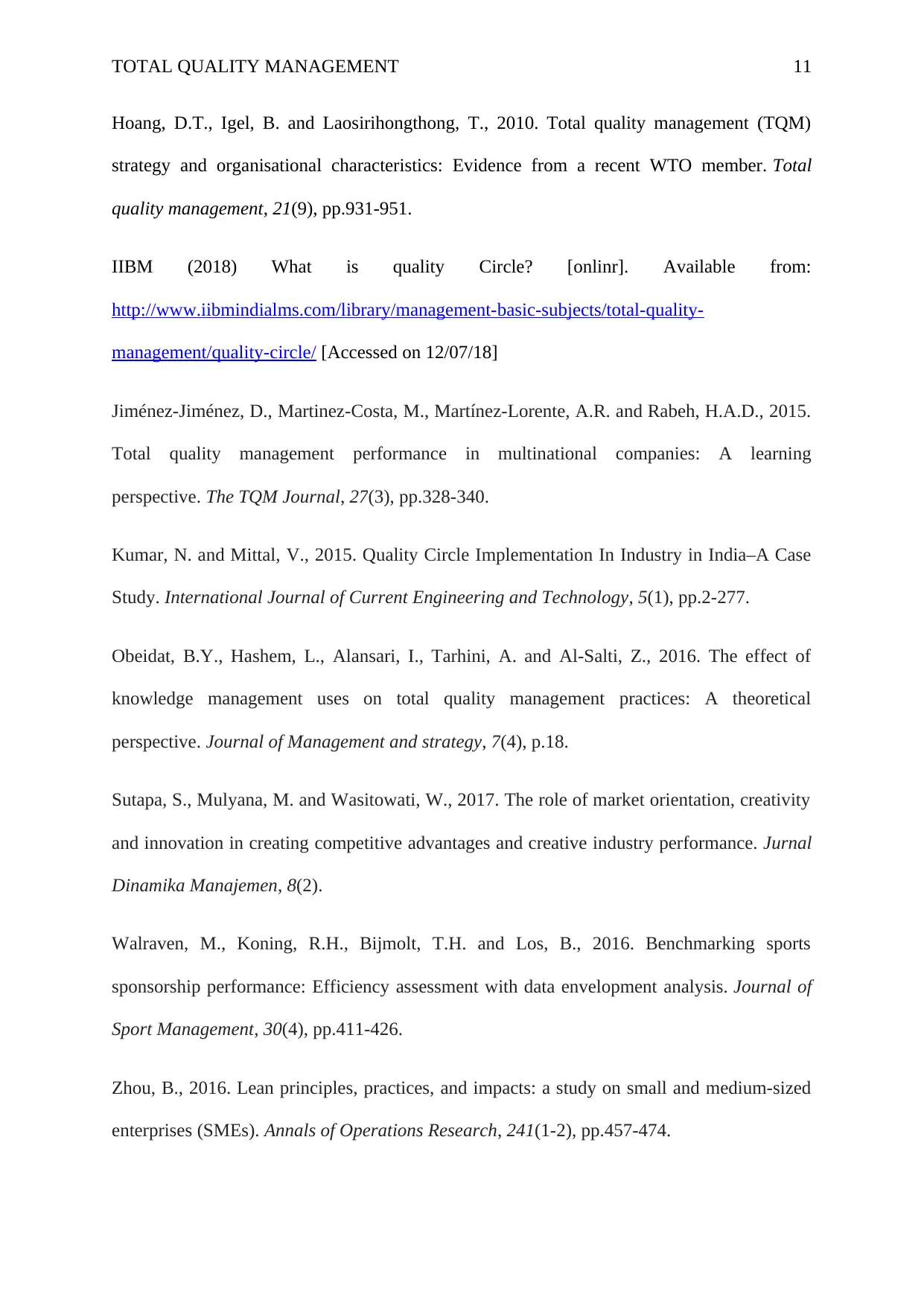
TOTAL QUALITY MANAGEMENT 11
Hoang, D.T., Igel, B. and Laosirihongthong, T., 2010. Total quality management (TQM)
strategy and organisational characteristics: Evidence from a recent WTO member. Total
quality management, 21(9), pp.931-951.
IIBM (2018) What is quality Circle? [onlinr]. Available from:
http://www.iibmindialms.com/library/management-basic-subjects/total-quality-
management/quality-circle/ [Accessed on 12/07/18]
Jiménez-Jiménez, D., Martinez-Costa, M., Martínez-Lorente, A.R. and Rabeh, H.A.D., 2015.
Total quality management performance in multinational companies: A learning
perspective. The TQM Journal, 27(3), pp.328-340.
Kumar, N. and Mittal, V., 2015. Quality Circle Implementation In Industry in India–A Case
Study. International Journal of Current Engineering and Technology, 5(1), pp.2-277.
Obeidat, B.Y., Hashem, L., Alansari, I., Tarhini, A. and Al-Salti, Z., 2016. The effect of
knowledge management uses on total quality management practices: A theoretical
perspective. Journal of Management and strategy, 7(4), p.18.
Sutapa, S., Mulyana, M. and Wasitowati, W., 2017. The role of market orientation, creativity
and innovation in creating competitive advantages and creative industry performance. Jurnal
Dinamika Manajemen, 8(2).
Walraven, M., Koning, R.H., Bijmolt, T.H. and Los, B., 2016. Benchmarking sports
sponsorship performance: Efficiency assessment with data envelopment analysis. Journal of
Sport Management, 30(4), pp.411-426.
Zhou, B., 2016. Lean principles, practices, and impacts: a study on small and medium-sized
enterprises (SMEs). Annals of Operations Research, 241(1-2), pp.457-474.
Hoang, D.T., Igel, B. and Laosirihongthong, T., 2010. Total quality management (TQM)
strategy and organisational characteristics: Evidence from a recent WTO member. Total
quality management, 21(9), pp.931-951.
IIBM (2018) What is quality Circle? [onlinr]. Available from:
http://www.iibmindialms.com/library/management-basic-subjects/total-quality-
management/quality-circle/ [Accessed on 12/07/18]
Jiménez-Jiménez, D., Martinez-Costa, M., Martínez-Lorente, A.R. and Rabeh, H.A.D., 2015.
Total quality management performance in multinational companies: A learning
perspective. The TQM Journal, 27(3), pp.328-340.
Kumar, N. and Mittal, V., 2015. Quality Circle Implementation In Industry in India–A Case
Study. International Journal of Current Engineering and Technology, 5(1), pp.2-277.
Obeidat, B.Y., Hashem, L., Alansari, I., Tarhini, A. and Al-Salti, Z., 2016. The effect of
knowledge management uses on total quality management practices: A theoretical
perspective. Journal of Management and strategy, 7(4), p.18.
Sutapa, S., Mulyana, M. and Wasitowati, W., 2017. The role of market orientation, creativity
and innovation in creating competitive advantages and creative industry performance. Jurnal
Dinamika Manajemen, 8(2).
Walraven, M., Koning, R.H., Bijmolt, T.H. and Los, B., 2016. Benchmarking sports
sponsorship performance: Efficiency assessment with data envelopment analysis. Journal of
Sport Management, 30(4), pp.411-426.
Zhou, B., 2016. Lean principles, practices, and impacts: a study on small and medium-sized
enterprises (SMEs). Annals of Operations Research, 241(1-2), pp.457-474.
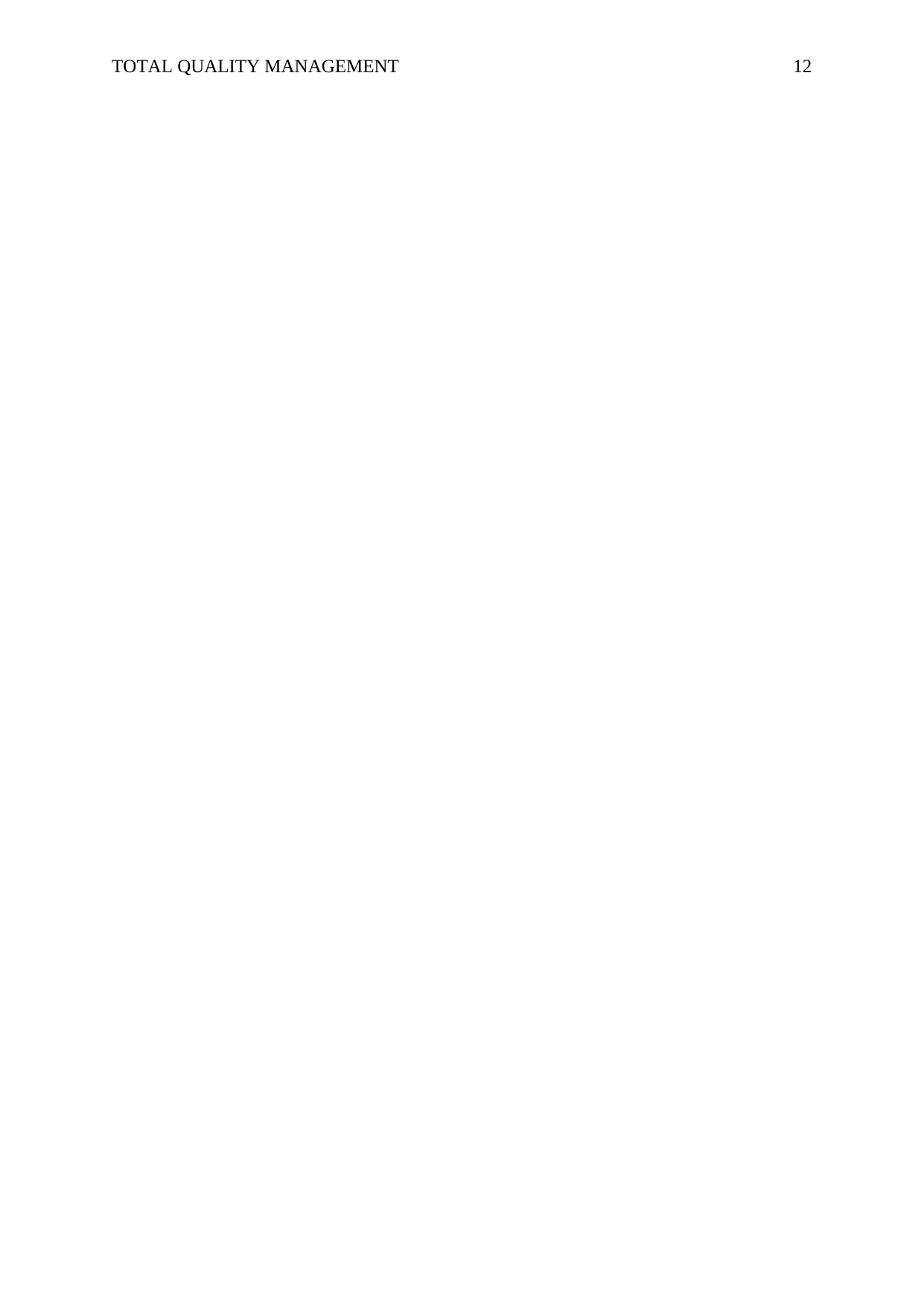
TOTAL QUALITY MANAGEMENT 12
Paraphrase This Document
Need a fresh take? Get an instant paraphrase of this document with our AI Paraphraser
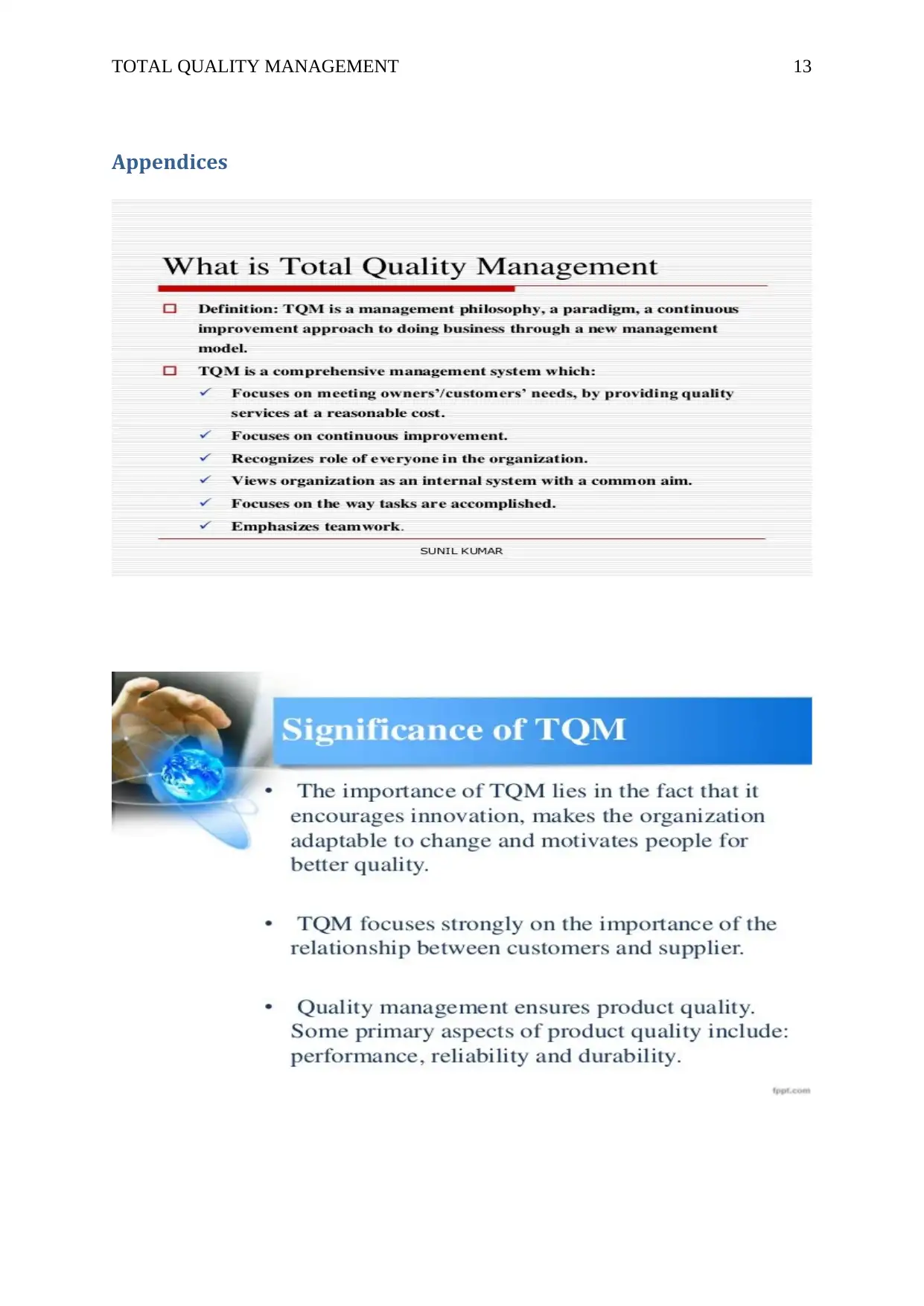
TOTAL QUALITY MANAGEMENT 13
Appendices
Appendices
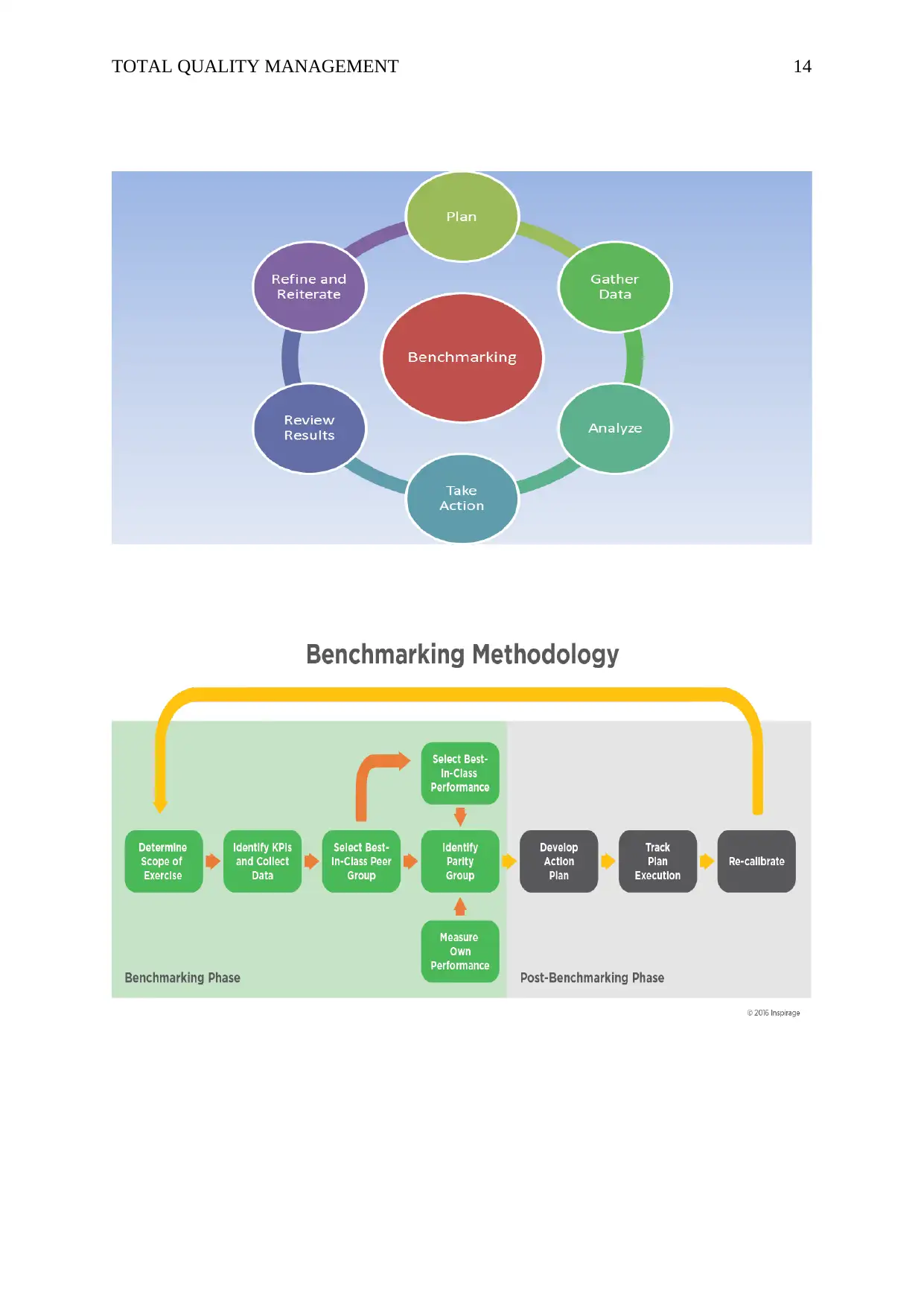
TOTAL QUALITY MANAGEMENT 14
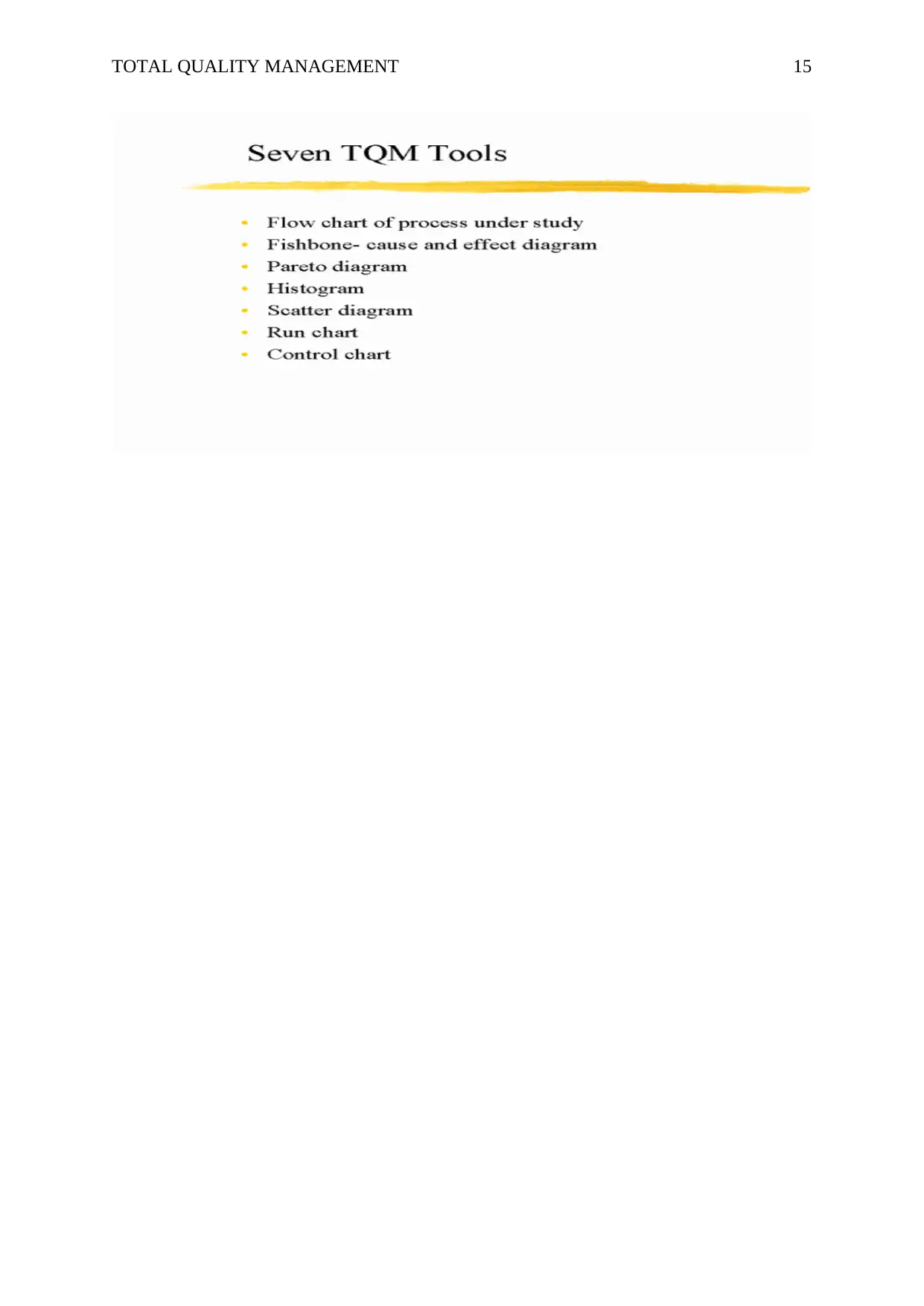
TOTAL QUALITY MANAGEMENT 15
1 out of 16
Related Documents
Your All-in-One AI-Powered Toolkit for Academic Success.
+13062052269
info@desklib.com
Available 24*7 on WhatsApp / Email
![[object Object]](/_next/static/media/star-bottom.7253800d.svg)
Unlock your academic potential
© 2024 | Zucol Services PVT LTD | All rights reserved.





